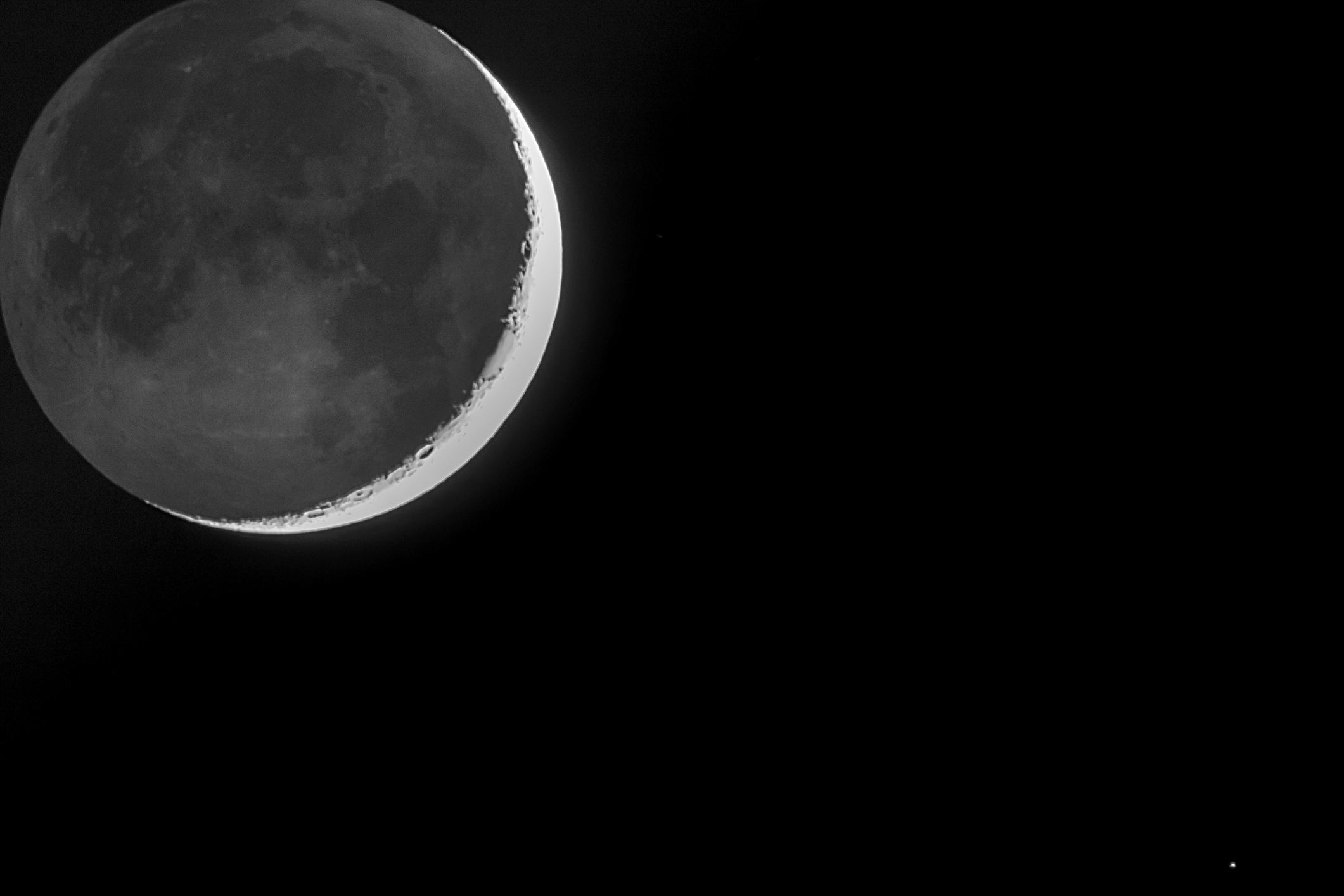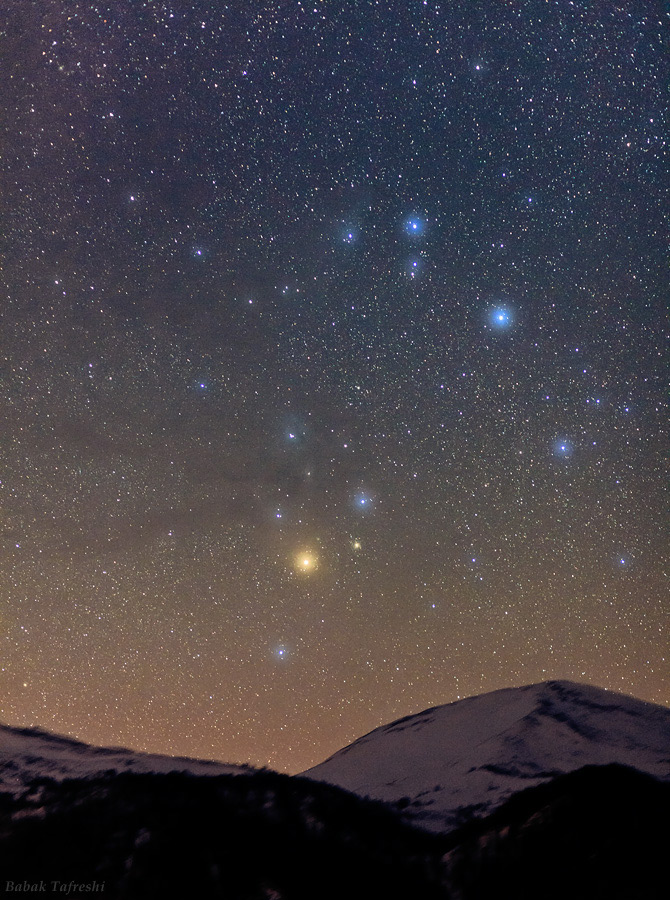See the moon eclipse the red supergiant star Antares tonight

As the moon makes its monthly circuit around the sky it often passes in front of stars, blotting them out for as much as an hour or so.
Such an event is called an occultation (derived from the Latin word occultāre, which means "to conceal."), and it can be a startling spectacle, especially if the star happens to be bright. The star appears to creep up to the moon's limb, hangs on the edge for a minute or two, and then, without warning, abruptly winks out. Later it pops back into view just as suddenly on the other side of the moon.
The suddenness with which occultations take place was among the first proof that the moon has no atmosphere. If our natural satellite were wrapped in an atmosphere, a star approaching its limb would appear to fade away gradually, just like one seen setting beyond the western horizon from here on Earth.
On your calendar, make sure to put a big circle around the evening Thursday (Aug. 24), for on that evening the 57% illuminated waxing gibbous moon will occult the 1st-magnitude red supergiant star Antares, the fifteenth brightest star in the sky.
Related: Night sky, August 2023: What you can see tonight [maps]
Region of visibility

Want to see Antares pass behind the moon? We recommend the Celestron Astro Fi 102 as the top pick in our best beginner's telescope guide.
The star's disappearance will be spectacular wherever the moon is up in a dark sky. Like a switch being thrown, Antares will appear to abruptly blink out behind the moon's dark limb, a sight that should be able to be seen with the unaided eye if you have good vision. However, the moon's glare might hinder the visibility of Antares. So, block as much of the moon's sunlit portion as you can with a finger, a telephone pole or the edge of a building at least 20-feet away. Binoculars will pull the star in well, and a small telescope will afford a superb view.
A drawback for those living in the Northeastern U.S. is that Antares and the moon will be very low in the west-southwest sky when the star disappears behind the moon's dark limb. Your clenched fist held out at arm's length measures roughly 10 degrees in the night sky. From Washington, D.C., the moon will be 9 degrees above the horizon, from New York its 6 degrees and for Boston it's only 3 degrees — only about one third of a fist!
Breaking space news, the latest updates on rocket launches, skywatching events and more!
And unfortunately, the star's reappearance occurs after the moon has already set. For those located farther south across the Southeastern U.S. (such as at Atlanta), the moon will appear higher in the sky and both the disappearance and reappearance will be visible.
A path only a few miles wide at most will run roughly from Florida's Big Bend Seagrasses Aquatic Preserve east-northeast across northern Florida to St. Augustine Beach. This marks the southern limit of the occultation. For those who live in Gainesville, Florida, the fiery red star may spectacularly flash in and out of sight a number of times as it is clipped by lunar mountains along the moon's dark southern limb for several minutes centered on 11:22 p.m. EDT. Those on the Florida peninsula who live below this path will see the moon narrowly miss Antares. From Miami, for instance, Antares will miss the moon's lower limb by a scant 3 arc minutes — or one-tenth of the apparent diameter of the moon.
The central U.S. will have the best view of this event, with both the disappearance and reappearance of Antares occurring in a dark sky.
Across the Mountain time zone, seeing Antares disappear will be complicated by the fact that the disappearance occurs either just before sunset or at dusk against a bright twilight sky. But when Antares reappears along the moon's bright limb about an hour later, the sky will be much darker.
Sadly, for those in the Pacific time zone, the entire occultation will take place before sunset.
A "wily companion" star
Adding even more interest to this event for those who will be watching under a dark sky is Antares' 5th-magnitude companion star, Antares B, which was discovered from Vienna, Austria by Professor Johann Tobias Burg during the Antares occultation of April 13, 1819. Since this faint secondary star is 2.7 arc seconds due west from Antares, it will always reappear five seconds before Antares itself. (To appreciate how small 2.7 arc seconds is, the moon's apparent width averages 1,800 arc seconds in diameter. So, Antares and its companion are separated by 1/667 of a moon diameter, or 0.00075 degrees!). American astronomer, Mary Proctor (1862-1957) referred to it as "the wily companion of Antares."
The upcoming occultation will present a rare, albeit brief chance to catch a glimpse of the companion star as it pops into view before Antares. The problem is, this will all happen along the moon's bright limb making it very difficult to see.
What to expect
In the table below, we provide a timetable for 14 selected locations, giving the local times and the moon's altitude for both Antares' disappearance and reappearance. A single asterisk (*) means the event occurs during evening twilight. "Daylight" indicates that Antares disappears behind the moon's dark limb before sunset.
If Antares reappears from behind the moon after the moon has set, the notation "Not visible" is used. The information is based on predictions by the International Occultation Timers Association (IOTA) and has been rounded off to the nearest minute.
| Location | Time zone | Antares disappears | Altitude | Antares reappears | Altitude |
|---|---|---|---|---|---|
| Atlanta | EDT | 10:53 p.m. | 17 degres | 11:37 p.m. | 10 degres |
| Austin | CDT | 9:33 p.m. | 28 degrees | 10:23 p.m. | 22 degrees |
| Boston | EDT | 10:55 p.m. | 3 degrees | Not visible | - |
| Chicago | CDT | 9:29 p.m. | 14 degrees | 10:33 p.m. | 6 degrees |
| Denver | MDT | 8:01 p.m.* | 23 degrees | 9:11 p.m. | 19 degrees |
| Great Falls | MDT | Daylight | - | 8:56 p.m.* | 14 degrees |
| Kansas City | CDT | 9:20 p.m. | 20 degrees | 10:27 p.m. | 13 degrees |
| Montreal | EDT | 10:43 p.m. | 4 degrees | Not visible | - |
| New Orleans | CDT | 9:51 p.m. | 23 degrees | 10:31 p.m. | 17 degrees |
| New York | EDT | 10:54 p.m. | 6 degrees | Not visible | - |
| Phoenix | MST | Daylight | - | 7:55 p.m.* | 28 degrees |
| Salt Lake City | MDT | Daylight | - | 8:57 p.m. | 21 degrees |
| Washington, D.C. | EDT | 10:54 p.m. | - | Not visible | - |
| Winnipeg | CDT | 9:03 p.m.* | 12 degrees | 10:15 p.m. | 7 degrees |
Next time?
If poor weather prevents you from getting a view of this "Antares eclipse," the next opportunity to see the moon cross in front of this star will come during the predawn hours of March 3, 2024. However, only the Southeastern U.S. will be able to partake in this event; the rest of the country will witness a near miss between moon and star.
If you are hoping to catch a look at the moon and Antares together, our guide to the best binoculars could help you find some nice wide-angle optics for taking in larger areas of the sky. Or, if you want to take a closer look at either one, our guide to the best telescopes can help you find the gear you need.
And if you're looking to take photos of these celestial objects or the night sky in general, check out our guide on how to photograph the moon, as well as our best cameras for astrophotography and best lenses for astrophotography.
Joe Rao serves as an instructor and guest lecturer at New York's Hayden Planetarium. He writes about astronomy for Natural History magazine, the Farmers' Almanac and other publications.
Editor's Note: If you snap an image of the lunar occultation of Antares and would like to share it with Space.com's readers, send your photo(s), comments, and your name and location to spacephotos@space.com.

Joe Rao is Space.com's skywatching columnist, as well as a veteran meteorologist and eclipse chaser who also serves as an instructor and guest lecturer at New York's Hayden Planetarium. He writes about astronomy for Natural History magazine, Sky & Telescope and other publications. Joe is an 8-time Emmy-nominated meteorologist who served the Putnam Valley region of New York for over 21 years. You can find him on Twitter and YouTube tracking lunar and solar eclipses, meteor showers and more. To find out Joe's latest project, visit him on Twitter.


